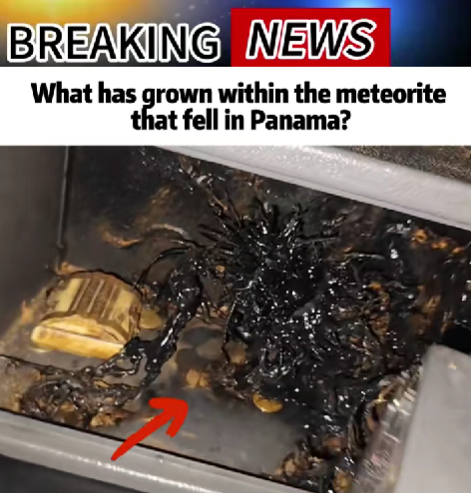A strange and unsettling discovery has left scientists scratching their heads after a meteorite that fell in Panama revealed something no one expected — a black, vine-like substance growing inside its core. The bizarre find has sparked global speculation, with experts and conspiracy theorists alike debating whether it’s an unknown form of life or a chemical phenomenon unlike anything seen before.
The meteorite was discovered last week in a rural area outside Colón, Panama, after locals reported hearing a loud explosion followed by a flash of light streaking across the night sky. When residents approached the impact site, they found a small crater and fragments of a dark, metallic rock that seemed to pulse with residual heat.
At first glance, it appeared to be a typical space rock — until scientists at a nearby university opened it for examination. Inside, they found twisted, root-like tendrils coated in a tar-like substance, glistening under the lab lights. The material appeared to be growing — slowly expanding and attaching itself to the container walls.
Dr. Natalia Fuentes, the lead geochemist on the investigation, admitted her team was stunned. “We’ve studied hundreds of meteorites,” she said, “but this is the first time we’ve seen something organic — something active — inside one.”
Tests conducted so far have ruled out common contaminants like mold or fungus. The substance doesn’t match any known Earth-based microorganism, and its molecular structure appears to contain elements arranged in patterns rarely found in terrestrial compounds. Even more strangely, when exposed to light, the growth seems to contract — as if reacting defensively.
The discovery has already attracted attention from major research agencies and private labs worldwide. NASA has reportedly requested samples for independent testing, while Panama’s national science council has cordoned off the site to prevent unauthorized access.
Online, the story has exploded into a frenzy of speculation. Some claim the growth could be proof of extraterrestrial biology, while others warn it might be a dangerous contaminant. A few conspiracy theorists have even compared it to fictional parasitic life forms seen in movies like The Thing or Venom.
However, scientists urge caution before jumping to conclusions. “It’s far too early to call it alien life,” said astrobiologist Dr. Ian Morales. “But it’s absolutely fair to say we’ve never seen anything quite like this before. Whether it’s chemical, biological, or something in between, it challenges our understanding of what can survive — or form — in space.”
As the investigation continues, researchers are taking extreme precautions, storing the meteorite fragments in sealed, temperature-controlled containment units. Any exposure to open air could trigger unpredictable reactions.
For now, the Panama meteorite remains one of the most intriguing scientific mysteries of the year. Whether it’s a natural anomaly or the first glimpse of something truly out of this world, one fact is undeniable — whatever has grown inside this rock from the stars is rewriting what we thought we knew about life itself.
